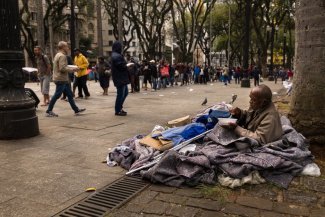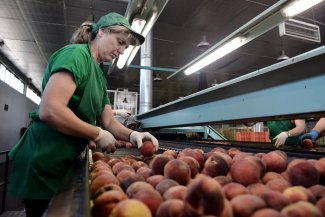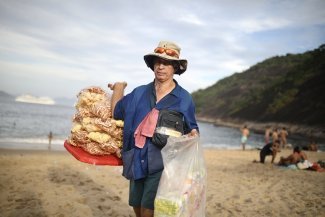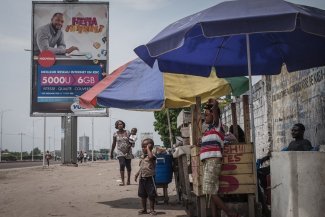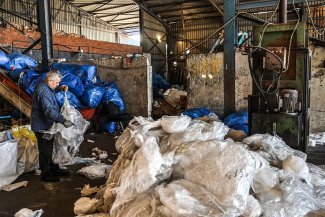A woman fills a container with water from a spring in the centre of Caracas, the capital of Venezuela, one of many regions affected by water shortages.
Venezuela ranks number nine in the world in renewable freshwater resources. However, the state, which is responsible for supplying these resources, guarantees neither their quality nor their availability. In fact, the opposite is true, and the country’s worsening water crisis, which affects 90 per cent of its population, is pushing the most vulnerable Venezuelans into food insecurity.
As recently reported by the United Nations Office for the Coordination of Humanitarian Affairs (OCHA), the lack of safe water makes it difficult for many communities in the South American country to access safe food. According to the NGO Agua Sin Fronteras, 82 per cent of Venezuela’s inhabitants are exposed to the consumption of unsafe water due to inoperable water treatment plants.
By 2000, Venezuela had water systems with enough capacity to produce and distribute 160,000 litres of water a second. Currently, however, due to lack of maintenance and investment in the sector, the country can only pump 55,000 litres per second. According to a report by the local organisation Monitor Ciudad, which advocates for access to water as a human right, only 34 per cent of the US$6.426 billion approved between 2000 and 2015 for plans and improvements by the state-owned company Hidrológica de la Región Capital (Hidrocapital) was actually invested. Hidrocapital is responsible for drinking water and sanitation services in three of Venezuela’s most populous states, Distrito Capital, Miranda and Vargas, which together account for 20 per cent of the country’s total population. “70 per cent of the resources were effectively lost,” says Jesús Armas, director of Monitor Ciudad.
In 2014, Nicolás Maduro made water rationing official with his so-called ‘Supply Plan’. At the time, officials in his administration cited “critical” levels of rainfall and the resulting drought to justify the measures. While drought conditions have subsequently improved, interruptions in service have continued.
In 2018, the United Nations Food and Agriculture Organisation (FAO) recognised that climate change has had “a major impact on Venezuelan agriculture, affecting food and nutritional security”. This by no means exonerates the government’s poor water management, since water is fundamental to guaranteeing food security in any context.
As nutritionist Marianella Herrera, president of the Venezuelan Health Observatory, tells Equal Times, there is a close correlation between the regions of Venezuela with the highest levels of food insecurity and those that report serious water supply failures.
“We don’t have studies on food insecurity as it specifically relates to water scarcity. But [the data collected by Venezuelan public services and health observatories] show a significant correlation between lacking public services and food insecurity, which is greater in the southern region and in states such as Sucre, Apure and Falcón, where residents lack the ability to properly cook their food. If you are unable to cook, what do you do with all the beans you have? You can’t eat them raw. You may have a kilo of beans but if you are unable to cook them you are also food insecure,” explains Herrera, who is also a researcher at the Centre for Development Studies (Cendes).
In a 2019 assessment, the United Nations World Food Programme (WFP) determined that 92 per cent of the Venezuelan population suffered from food insecurity, making it one of the 10 worst food crises on the planet that year. Beginning the following year in 2020, however, the UN agency has not included Venezuela its reports on nutrition due to lack of information. Its 2022 report Hunger Hotspots: FAO-WFP early warnings on acute food insecurity merely states that food insecurity in the country is likely getting worse.
For almost a decade, there have been no official figures on food availability in the country. As Herrera and other experts have argued, this lack of transparency affects the creation of public policies that can effectively address the serious effects of extreme food insecurity.
According to Herrera, who is also a member of the board of the Bengoa Food and Nutrition Foundation, one of the priority issues that must be addressed is water quality. In Venezuela’s low-income and rural areas, water does not meet minimum safety criteria. In Herrera’s opinion, this not only increases the risk of consuming contaminated water but also the proliferation of infectious gastrointestinal diseases.
Water scarcity has led people to change their diets in order to save water
Mario Figuera, a resident of Las Lluvias, a community in the northern coastal state of Vargas, tells Equal Times that because he has not received piped water for more than four years, his family has to pay US$10 a month for spring water. “We store it in plastic containers, fill the jugs and limit ourselves to making meals like rice and pasta, which consumes the least amount of water. We have stopped making soups, for example,” he says.
According to Herrera, the dietary changes that Venezuelans have been forced to adopt mean that people are unable to cook in a “safe and healthy way, without affecting food safety”.
While there has been no official government response to the water crisis, non-governmental organisations are working together in a practical way to guide and educate the population on how to address and alleviate its effects.
Humanitarian organisations like Cáritas Venezuela have developed workshops on the correct use of rainwater harvesting systems and distributed handmade water filters and information leaflets on water as a human right. They have given talks to teach people how to protect themselves against water-born parasites and water purification methods. During the Covid-19 pandemic, Cáritas Venezuela gave virtual courses on water sanitation which were taken by over 350 people.
Meanwhile, through its liaisons in the country, the FAO is working on developing agroclimatic community roundtables (MCA) in rural communities in Venezuela. Made up of technical staff from public and private entities linked to the agricultural sector and local families, this pilot project is aimed at developing programmes that lead to an “increase in agricultural production, sovereignty and food and nutritional security”.
The project was carried out in the Andean states of Mérida, Trujillo and Portuguesa. There are currently no plans to promote it in other regions. It should be noted that all these activities are being financed by the European Union, with the FAO administering resources.
According to the FAO website in Venezuela: “The MCAs are key to preparing farming families for agroclimatic disaster risk management, avoiding damage and losses to their crops and livestock, guaranteeing the sustainability of agricultural production and protecting their livelihoods.”
While the FAO stresses that these roundtables can help the country to transform its agri-food systems and make them more efficient, Juan Marrero, a researcher in food security and agrarian law at the Institute of Agricultural Economics, believes that state policies should also be created to address the management of water resources other than rainfall, including groundwater, aquifers or reservoirs.
Marrero makes it clear that the rehabilitation and conservation of hydrographic structures is a priority as “there is a direct relationship between water and food security”. Water is necessary for agriculture, which consumes 70 per cent of the world’s water in irrigation processes.
“There are water management issues. Climate change is of course a problem but we should have prepared ourselves a long time ago so that the consequences of climate change would not affect us as much as they do during a bad rainy season, considering that Venezuelan agricultural land is rain-fed,” says Marrero, a graduate of the Central University of Venezuela (UCV).
Alternative solutions and the SDGs
Worldwide, 1.2 billion people live in agricultural areas with severe water problems. The FAO recommends reusing freshwater resources, increasing the safe use of wastewater and investing in rainwater harvesting. According to the agency: “Doing so will not prevent a drought from occurring, but it can help in preventing droughts from resulting in famine and socioeconomic disruption”.
Marrero, who is also a member of the Right to Food Observatory for Latin America and the Caribbean, agrees with the FAO on this point. “With all these changes taking place, without storage systems, Venezuelan producers are going to have a very hard time and food production is going to drop,” he says.
Furthermore, as he points out, general precariousness within the agricultural sector means that alternative solutions such as drilling for reliable water sources or using motor pumps to bring water from lagoons and streams to crops are out of reach for most farmers.
Despite the scarcity of water, part of the limited amount that is distributed is wasted, due in part to piping problems. Food waste in the country is also notorious: in 2020 alone, 60,000 tonnes of food were wasted a month throughout the country. This waste is due in part to the absence of “a rational and coherent public policy” of agricultural resilience, says Marrero. More specifically, this is due to the difficulties that farmers encounter in distributing their food (due to a lack of fuel, for example).
The United Nations projects the world’s population to reach 10 billion people by 2050, which means an increase in demand for food and, consequently, for water. Adopting resilient water resource management is essential to increasing the efficiency and sustainability of agricultural practices in order to avoid droughts that wipe out entire crops and exacerbate malnutrition.
Given this data, Venezuela should join the rest of the world in reducing its water footprint and changing its consumption habits, which could lead to a reduction in the level of water lost through food waste.
The country still has time to contribute to meeting the Sustainable Development Goals related to zero hunger and safe, clean and affordable water for all. But the necessary actions must be taken to build resilience in farming communities, overcome constraints on water accessibility and demand, and raise awareness of the role of water in the food value chain.




